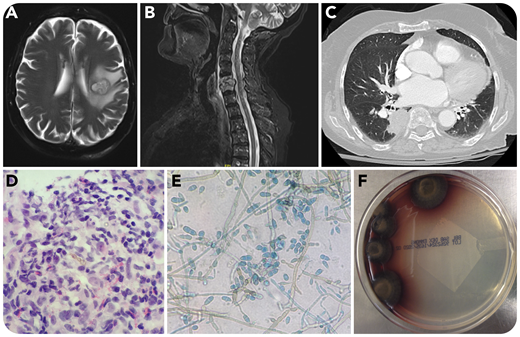An 84-year-old woman with hypertension, gastroesophageal reflux disease, and polycythemia vera with progression to myelofibrosis on ruxolitinib presented with weakness, falls, dysarthria, and right-sided facial droop. Imaging revealed a 2.1-cm left frontoparietal mass (panel A), a C5/6 osteomyelitis with surrounding phlegmon (panel B), and a 4.3-cm right lower lobe lung mass (panel C). A lung biopsy and fungal culture revealed findings consistent with Verruconis gallopava: pigmented septate hyphae on hematoxylin and eosin (panel D, 40× objective; total magnification, ×400), red-brown with a velvety texture mold colonies (panel F), and 2-celled elongate conidia by lactophenol blue stain (panel E, 40× objective; total magnification, ×400).
Verruconis species are thermotolerant, dematiaceous fungi that can be found in soil, decaying vegetation, hot springs, and so on. It is hypothesized that the organism is transmitted through inhalation or inoculation through direct trauma. V. gallopava is known to cause fatal encephalitis in birds; however, it has been implicated in opportunistic infections, particularly in recipients of solid organ transplants, causing cavitary and noncavitary lung lesions and central nervous system infections. Ruxolitinib, an inhibitor of JAK1/JAK2, is approved for use in polycythemia vera and myelofibrosis and reduces disease-related symptoms and transfusion dependence. Long-term data have suggested an increased rate of certain infections, particularly tuberculosis; however, literature describing infections by Verruconis is sparse.
An 84-year-old woman with hypertension, gastroesophageal reflux disease, and polycythemia vera with progression to myelofibrosis on ruxolitinib presented with weakness, falls, dysarthria, and right-sided facial droop. Imaging revealed a 2.1-cm left frontoparietal mass (panel A), a C5/6 osteomyelitis with surrounding phlegmon (panel B), and a 4.3-cm right lower lobe lung mass (panel C). A lung biopsy and fungal culture revealed findings consistent with Verruconis gallopava: pigmented septate hyphae on hematoxylin and eosin (panel D, 40× objective; total magnification, ×400), red-brown with a velvety texture mold colonies (panel F), and 2-celled elongate conidia by lactophenol blue stain (panel E, 40× objective; total magnification, ×400).
Verruconis species are thermotolerant, dematiaceous fungi that can be found in soil, decaying vegetation, hot springs, and so on. It is hypothesized that the organism is transmitted through inhalation or inoculation through direct trauma. V. gallopava is known to cause fatal encephalitis in birds; however, it has been implicated in opportunistic infections, particularly in recipients of solid organ transplants, causing cavitary and noncavitary lung lesions and central nervous system infections. Ruxolitinib, an inhibitor of JAK1/JAK2, is approved for use in polycythemia vera and myelofibrosis and reduces disease-related symptoms and transfusion dependence. Long-term data have suggested an increased rate of certain infections, particularly tuberculosis; however, literature describing infections by Verruconis is sparse.
For additional images, visit the ASH Image Bank, a reference and teaching tool that is continually updated with new atlas and case study images. For more information, visit http://imagebank.hematology.org.


This feature is available to Subscribers Only
Sign In or Create an Account Close Modal